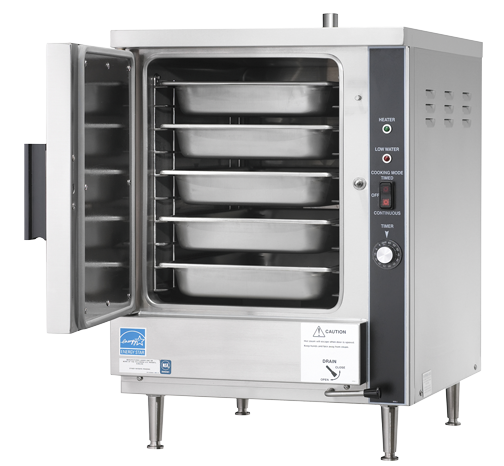Steamers play a large role in many kitchens and offer a great technique for cooking that produces very nutritious and enjoyable food. Steam is a great way to cook food with many restaurants and food service establishments having adopted steamers as a primary piece of equipment in their kitchens.
At MegaTec we have expert and friendly professionals who have long years of experience working with various kinds kitchen and restaurant equipment pieces including commercial steamers. We serve the the Greater Vancouver area.
There are several different types of steamers to choose from that all have their own advantages and specific toolsets for certain situations. There are three basic categories to choose from: convection steamers, pressure steamers, and pressure/pressureless steamers.
Convection Steamers Also called pressureless steamers, are the most popular steamer on the market. Convection steamers feature a boiler placed in the cabinet base separated from the steam compartments. Meanwhile, the steam compartments are vented and pressureless. This style of steamer is great for producing a large variety of foods that include frozen/fresh vegetables and frozen/fresh seafood, amongst others food such as rice, eggs, and pasta. In addition to this, convection steamers have sub-categories of their own.
Connectionless Steamers Many establishments find the connectionless convection steamer to be most well suited to their needs. Connectionless steamers do not have a water line or drain, but rather generate steam within the piece of equipment through water that is manually loaded into the cooking compartment. This prevents technical issues and troubles that can arise from traditional convection steamers.
Boilerless Steamers These steamers do require water connections but remove the necessity to manually fill the steamer. A commercial floor model steamer can be a great addition to many kitchens, but not every venue has the space for a full size model, and boiler based steamers require a fair amount of energy and more labor to maintain. That’s why we here at Restaurant Equipment Solutions have assembled a collection of commercial boilerless countertop steamers! These units have no boiler typically using a reservoir of water at the bottom of the steam chamber to steam the food and condensers to collect the water again, meaning you use less water and have to refill the reservoir less often. These are great for restaurants that have seafood on the menu, establishments that serve Asian style cuisine
Pressure Steamers When a regular countertop steamer just can’t get the job done, that’s when it’s time for a commercial pressure countertop steamer. Like other commercial countertop steamers, these units use steam to cook the food within the chamber. In a normal environment, steam rapidly loses its heat and condenses. But a pressure steamer completely seals the cooking chamber and increases the pressure within, allowing for there to be more steam particles at a much higher temperature. The end result is that commercial pressure countertop steamers reach much higher temperatures and can cook food much, much faster than a typical restaurant steamer, and they take up only a fraction of the space.
Pressure/Pressureless Another type of steamer is the “pressure/pressureless steamer” which functions as either a pressure steamer or pressureless steamer. This piece of equipment is very versatile and good for establishments that have a broad, varied menu.
Combi Ovens are one of the newest, most popular trends in the food service industry, and with good reason. A commercial combi oven combines the properties of steam heat and convection heat to cook food more quickly while retaining essential juices and flavor. In addition, a combi oven does all this while taking up half as much space in the kitchen as it would take to purchase separate ovens.
